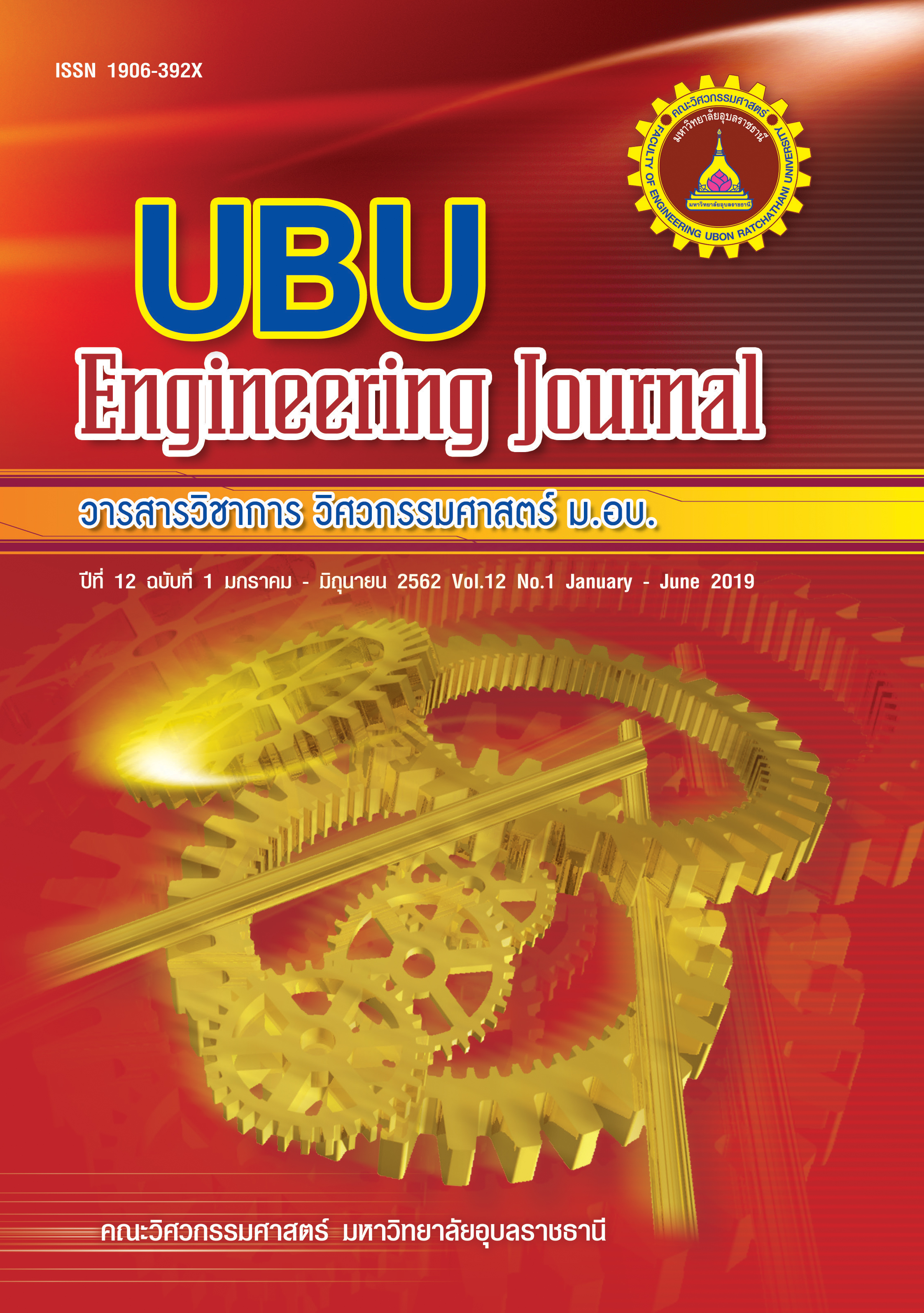Effect of Crosslink Agents and Sauna Period in Crosslink Process on Mechanical Properties of Polyoxymethylene
Main Article Content
Abstract
This study investigated the feasibility of using silane crosslinking technology to improve mechanical properties of polyoxymethylene (POM). The study determined effects of the amount of crosslink agent (1, 3, and 5) parts per 100 and Sauna incubation Period (0, 24, 72, and 120 hours) in the crosslink process which affected the mechanical properties of polyoxymethylene using statistics process. Results from mechanical property tests and statistical analysis showed that the grafting reactions from the factor of crosslink agent had significantly higher influence on the mechanic properties of polyoxymethylene than had the factor of Sauna Period. Increasing the amount of crosslink agent resulted in higher modulus of elasticity and hardness. However, the melting index was lower due to the higher chain grafting reaction. Increasing the Sauna Period increased the tensile and modulus elasticity properties of the polyoxymethylene, but reduced the percent elongation. The investigation of morphology of cracks using scanning electron microscope revealed the effects of both factors on the mechanical properties of polyoxymethylene. Finally, polyoxymethylene which was added with one percent crosslink agent and the 24-hour Sauna Period had similar hardness and modulus elasticity properties, but with higher tensile and percent elongation properties.
Article Details
References
[2] Sánchez M, Illescas S, Milliman H, Schiraldi, Arostegui A. Morphology and thermo-mechanical properties of melt mixed polyoxy-methylene/polyhedral oligomeric sil-sesquioxane nanocomposites. Macromolecular Materials and Engineering. 2010; 295: 143–154.
[3] Sirirat W, Supakanok T, Akaraphol P, Chaturong E. Effect of particle sizes of zinc oxide on mechanical, thermal and morphological properties of polyoxymethy-lene/zinc oxide nanocomposites. Polymer Testing. 2008; 27: 971–976.
[4] Xiaowen Z, Lin Y. Structure and mechanical properties of polyoxymethylene/ multi-walled carbon nanotube composites. Composites: Part B. 2011; 42: 926–933.
[5] Xiaodong W, Xiuguo C. Effect of ionomers on mechanical properties, morpho-logy, and rheology of polyoxymethylene and its blends with methyl methacrylate–styrene–butadiene copolymer. European Polymer Journal. 2005.; 41: 871–880.
[6] Sirirat W, Tanakorn S. Mechanical and Morphological Properties of Polypro-pylene/Polyoxymethylene Blends. Advances in Chemical Engineering and Science. 2013; 3: 202–205.
[7] Keizo M, Song C. Radiation Processing of Polymer Materials and Its Industrial Applications. John Wiley & Sons; 2012. p. 376–377.
[8] Jaya M, Vivek KS. Cross-linking in Hydrogels - A Review. American Journal of Polymer Science. 2014; 4(2): 25–31.
[9] Tseng-Sin W. Silane crosslink able polyethylene compounds: applications and manufacturing methods. Plastics, Additives and Compounding. 2007; 9(6): 40–43.
[10] กัลยาณี สิริสิงห. การเตรียม สมบัติและการใช้งานของพอลิเอทิลีนชนิดความหนาแน่นสูงที่มีโครงสร้างร่างแหไซลอกเซน. ภาควิชาเคมี คณะวิทยาศาสตร์ มหาลัยมหิดล. 2013.
[11] อนุชิต คงฤทธิ์, จิตติวัฒน์ นิธิกาญจนธาร. การศึกษาสมบัติเชิงกล ของพอลิเอทิลีนชนิดนำกลับมาใช้ใหม่ที่มีโครงสร้างร่างแหโดยการวิเคราะห์ทางสถิติ. รายงานสืบเนื่องการประชุมวิชาการข่ายงานวิศวกรรมอุตสาหการ ประจำปี 2558. กรุงเทพฯ; 2558: หน้า 667–672.
[12] อนุชิต คงฤทธิ์, กนกวรรณ แช่มพุดซา, รัชนก แป้นโพธิ์กลาง, พงษ์ศักดิ์ รุนกระโทก, จิตติวัฒน์ นิธิกาญจนธาร. อิทธิพลของสารคู่ควบต่อสมบัติทางกลของพอลิเมอร์ผสมระหว่างพอลิโพรพิลีนรีไซเคิล และ พอลิเอทิลีนความหนาแน่นสูงรีไซเคิล. วารสารวิศวกรรมศาสตร์ มหาวิทยาลัยศรีนคริทรวิโรฒ. 2017; 11(2): 57–65.
[13] Kalyanee S, Marnviga B. Improved silane grafting of high-density polyethylene in the melt by using a binary initiator and the properties of silane-crosslinked products. Journal of Polymer Research. 2013.; 20: 120.
[14] Hamed A, Jalil M, Mehdi B. Silane Grafting and Moisture Crosslinking of Polyethylene: The Effect of Molecular Structure. Journal of Vinly & Additive Technology. 2009; 15(3): 184–190.
[15] Yeong-Tarng S, Chih-Ming L. Silane Grafting Reactions of LDPE, HDPE, and LLDPE. Journal of Applied Polymer Science. 1999; 74: 3404–3411.
[16] จิตติวัฒน์ นิธิกาญจนธาร, มาโนชริทินโย. การออกแบบและสร้างเครื่องตีเกลียวเส้นด้าย. วารสาร วิชาการ วิศวกรรมศาสตร์ ม. อบ. 2015; 8(2): 116–123.
[17] Zakir MOR. Graft Copolymers of Maleic Anhydride and Its Isostructural Analogues : High Performance Engineering Materials. International Review of Chemical Engineering. 2011; 3(2): 153–215.
[18] Shun Z, Zhengzhou W, Yuan H. Melt grafting of vinyltrimethoxysilane and water crosslinking of polypropylene/ethylene-propylene diene terpolymer blends. Journal of Polymer Research. 2009; 16: 173–181.
[19] Amit B, James WR, Paramita R. Polymer Grafting and Crosslinking. John Wiley & Sons; 2008.
[20] Kalyanee S, Marnviga B, Soontaree K. The effect of silane carriers on silane grafting of high-density polyethylene and properties of crosslinked products. Polymer Testing. 2010; 29: 958–965.
[21] Momtahan R, Ismaeil G, Mohammad K, Hamed A, Mojgan Z, Marzieh R. Silane crosslinking of poly(lactic acid) The effect of simultaneous hydrolytic degradation. eXPRESS Polymer Letters. 2015; 9(12): 1133–1141.
[22] ศูนย์เทคโนโลยีโลหะและวัสดุแห่งชาติ. ประเภทของพลาสติกย่อยสลายได้. เข้าถึงได้จาก: http://www2.mtec.or.th/th/special/biodegradable_plastic/type_de_plas.html. [2017.]
[23] Abdel-Hady EE, Sharkawy MRMEl. Effect of Gamma Irradiation on Polyoxymethy-lene Copolymer Studied by Positron Annihilation Lifetime Technique. In: Proceedings of the 7th Conference on Nuclear and Particle Physics. Sharm El-Sheikh; 2009: 662.

